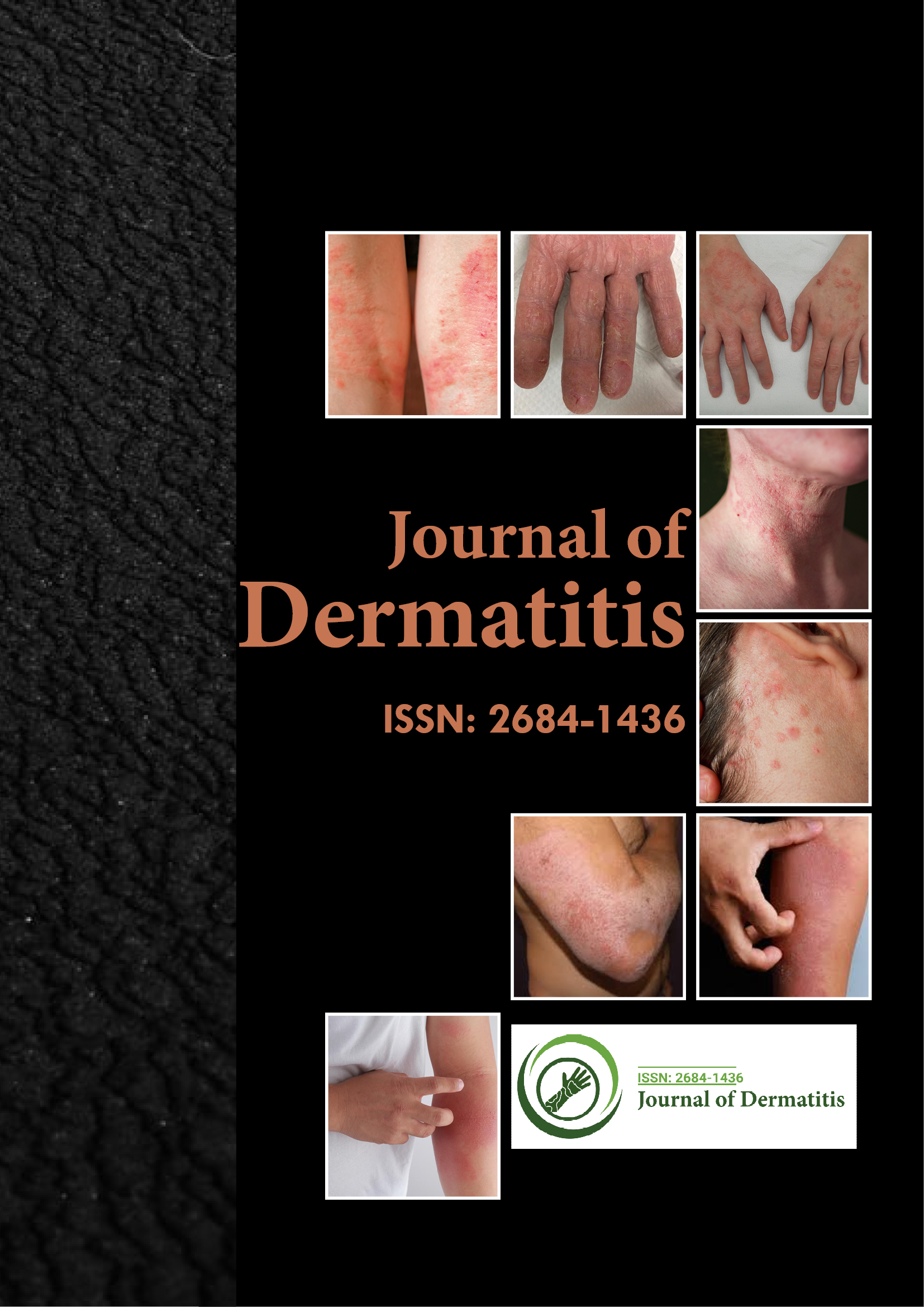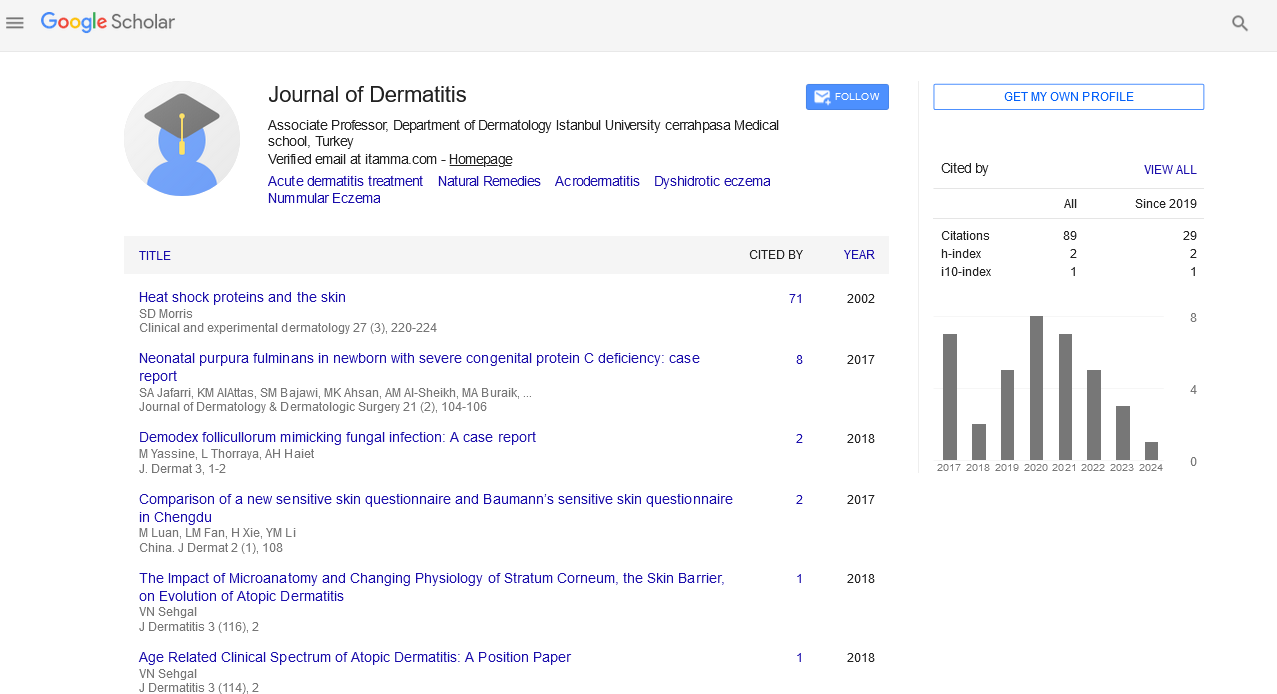Indexed In
- RefSeek
- Hamdard University
- EBSCO A-Z
- Euro Pub
- Google Scholar
Useful Links
Share This Page
Journal Flyer

Open Access Journals
- Agri and Aquaculture
- Biochemistry
- Bioinformatics & Systems Biology
- Business & Management
- Chemistry
- Clinical Sciences
- Engineering
- Food & Nutrition
- General Science
- Genetics & Molecular Biology
- Immunology & Microbiology
- Medical Sciences
- Neuroscience & Psychology
- Nursing & Health Care
- Pharmaceutical Sciences
Commentary - (2023) Volume 8, Issue 6
Role of the Microbiome in Dermatitis: Mechanisms of Skin Microbial Dysbiosis
Milad Spevi*Received: 17-Oct-2023, Manuscript No. JOD-23-23941; Editor assigned: 20-Oct-2023, Pre QC No. JOD-23-23941 (PQ); Reviewed: 03-Nov-2023, QC No. JOD-23-23941; Revised: 10-Nov-2023, Manuscript No. JOD-23-23941 (R); Published: 17-Nov-2023, DOI: 10.35248/2684-1436.23.8.223
Description
The human skin is home to a diverse and dynamic community of microorganisms collectively known as the skin microbiome. This complex ecosystem plays a pivotal role in maintaining the health and integrity of the skin. However, disruptions in this delicate balance can lead to a range of dermatological conditions, including dermatitis, a term used to describe inflammation of the skin. Dermatitis encompasses various conditions, such as atopic dermatitis, contact dermatitis, and seborrheic dermatitis, all of which can be influenced by the composition and function of the skin's microbial inhabitants. Understanding the mechanisms behind skin microbial dysbiosis in dermatitis is vital for advancing knowledge of these conditions and developing innovative therapeutic approaches.
Skin microbial dysbiosis refers to an imbalance or alteration in the composition and activity of the skin microbiome. In healthy skin, a diverse array of bacteria, viruses, fungi, and other microorganisms coexist harmoniously, contributing to the skin's defense against harmful invaders and maintaining its overall health. Dysbiosis occurs when this equilibrium is disrupted, resulting in an overgrowth of pathogenic microorganisms or a depletion of beneficial ones. This can trigger an inflammatory response, leading to the development or exacerbation of dermatitis.
One mechanism behind skin microbial dysbiosis in dermatitis is the disruption of the skin's barrier function. The outermost layer of the skin, the stratum corneum, acts as a protective barrier that keeps harmful microorganisms out and prevents excessive water loss. A healthy microbiome contributes to the maintenance of this barrier by producing antimicrobial peptides and other protective factors. In dermatitis, the microbial dysbiosis can weaken the barrier, making the skin more susceptible to irritants, allergens, and pathogens. This, in turn, can trigger or exacerbate inflammation, a key indicators of dermatitis.
Another mechanism involves the role of specific microorganisms in dermatitis development. Research has shown that certain species of bacteria, such as Staphylococcus aureus, are more prevalent in the skin of individuals with dermatitis. These pathogenic bacteria can outcompete beneficial species, disrupt the skin's pH balance, and secrete toxins and enzymes that further exacerbate inflammation. Additionally, the immune response to these pathogenic microbes can be heightened in individuals with dermatitis, leading to a cycle of chronic inflammation.
Moreover, the skin microbiome is involved in modulating the immune system's response in the skin. Dysbiosis can result in an imbalance in the skin's immune response, leading to an overactive or underactive state. In dermatitis, this imbalance can contribute to increased inflammation and sensitivity to allergens, exacerbating the condition. Researchers are increasingly exploring the use of probiotics and prebiotics to restore a balanced microbiome and modulate the skin's immune response as potential treatments for dermatitis.
Environmental factors also play a significant role in skin microbial dysbiosis. Exposure to allergens, pollutants, harsh chemicals, and a range of other external stressors can disrupt the balance of the skin microbiome, making it more susceptible to dysbiosis. Therefore, strategies to protect and support the skin barrier, such as using emollients and avoiding irritants, are essential in preventing or managing dermatitis.
In conclusion, the role of the skin microbiome in dermatitis is a complex and evolving field of research. Understanding the mechanisms of skin microbial dysbiosis is vital for developing innovative therapies to manage and prevent dermatitis. By targeting the microbial imbalance, fortifying the skin barrier, and modulating the immune response, researchers and clinicians are working towards more effective treatments for dermatitis, ultimately improving the quality of life for millions of individuals affected by these skin conditions.
Citation: Spevi M (2023) Role of the Microbiome in Dermatitis: Mechanisms of Skin Microbial Dysbiosis. J Dermatitis. 8:223.
Copyright: © 2023 Spevi M. This is an open-access article distributed under the terms of the Creative Commons Attribution License, which permits unrestricted use, distribution, and reproduction in any medium, provided the original author and source are credited.

